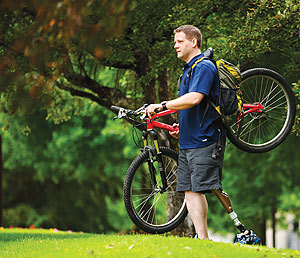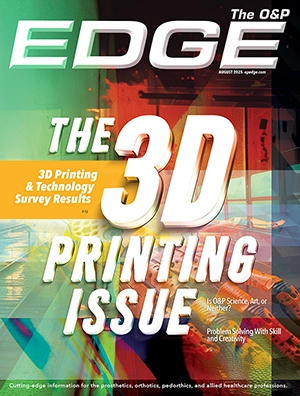Since their arrival on the U.S. prosthetic stage in 1999 with the Ottobock C-Leg®, microprocessor-controlled knees (MPKs) have arguably been one of the most significant advancements in transfemoral clinical care in prosthetic history. The C-Leg has become the most scientifically researched prosthetic device ever, with more than 40 published research studies, and more than 40,000 users worldwide. Since that first breakthrough device, other manufacturers have joined the MPK marketplace, which now offers a plethora of choices to consumers, clinicians, and prescribing physicians.
Not only has MPK technology achieved the anticipated mobility benefits, research and user feedback has revealed additional positive outcomes impacting the overall health and well-being of patients, including increased stability and confidence, reduced cognitive burden, higher quality of life, and expanded activity levels. Several studies have even suggested that swing-and-stance MPKs may actually elevate some users’ functional abilities to the next higher K-level when compared with nonmicroprocessor-controlled knees (NMPKs).
Doors Could Open to Wider World
“The relevance of [findings regarding improved K-level status] is that subjects who were previously considered unable to traverse more than low-level environmental barriers (MFCL [Medicare Functional Classification Level]-2), were able to achieve unlimited community ambulation and could walk with variable cadence (i.e., both level 3 traits), after exposure to the MPK,” according to a systematic literature review, “Outcomes Associated with the Use of Microprocessor-Controlled Prosthetic Knees among Individuals with Unilateral Transfemoral Limb Loss: A Systematic Review,” by Andrew B. Sawers, PhD, CPO, and Brian J. Hafner, PhD (the American Academy of Orthotists and Prosthetists State-of-the-Science Conference (the Academy’s SSC) Proceedings: Microprocessor-Controlled Knees, October 2013) .
The prospect that MPK technology may be able to improve less functional users’ abilities “challenges certain clinical and reimbursement paradigms,” since historically the recommendation for patients with lower ambulatory potential has been to use less expensive, simpler prostheses, with more complex and expensive technology considered only for the most active individuals, the authors noted. One common requirement for MPK prescription and reimbursement is the ability to walk with variable cadence. However, some studies suggest that it is the MPK that allows certain patients to achieve variable cadence. “Thus, these patients may be denied access to the very technology that may allow them to qualify for it,” Sawers and Hafner pointed out. “Though it is premature to suggest that this paradox exists based upon the existing evidence, these findings merit further investigation.”

Fear of falling is one of the most common fears people with a transfemoral amputation face, especially on uneven terrain, in crowds, or with unexpected need for quick movement, but the stability of MPKs may meet that challenge. “Current published studies have indicated that individuals wearing a microprocessor knee have an 88.1 percent increase in confidence and security and 88.4 percent improvement in gait and maneuverability when compared to a passive or nonmicroprocessor knee,” Dale Berry, CP, FAAOP, vice president, clinical operations, Hanger Clinic, headquartered in Austin, Texas, points out.
Sawers and Hafner’s literature review indicates that, when compared to NMPKs, swing-and-stance MPKs significantly decrease the number of subject-reported stumbles and falls and increase balance confidence. Frequency of falls decreases by as much as 64 percent with use of MPKs. For MFCL-2 subjects in one study, “an even more impressive 80 percent decrease was noted.”
Individuals’ biomechanical responses to physical perturbations with the NMPKs they wore originally as compared with the swing-and-stance MPKs they wore later similarly show improvements in standing and walking balance using MPKs. “[These results] may have may have long-term healthcare and cost implications by helping to prevent falls and resulting injuries.”
MPK DEVELOPMENTS
DAW® Industries, San Diego, California, U.S. distributor for Teh Lin Prosthetic & Orthopaedic, New Taipei City, Taiwan, revealed the new Stealth™ MPK, which utilizes triplanar linear acelerometers to accurately evaluate all positions and functions for greater safety and amputee control.
Chas A Blatchford & Sons, headquartered in Basingstoke, England, is developing an intelligent prosthesis integrating the ORION knee with the microprocessor-controlled elán foot, for expected release in 2015, according to Saeed Zahedi, PhD, Blatchford Clinical Services’ technical director. The new product, Linx®, uses sensors from the elán and ORION to input information to the master controller for decision making. The Linx uses more sensor density and a new output strategy for actuator controls of both the ORION and elán, Zahedi says. Blatchford’s U.S. branch, Endolite North America, is located in Miamisburg, Ohio.
Freedom Innovations, Irvine, California, will release a new version of the Plié knee this year featuring better water resistance, easier programming, and enhanced durability, according to Hogni Fridriksson, director of marketing and clinical services.
Nabtesco, Tokyo, Japan, is unveiling its third-generation knee, the Allux®, later this year, according to Leslie Roberts, MSS, CP, clinical and technical service manager for Nabtesco Proteor – USA, Muskego, Wisconsin. A polycentric stance-and-swing phase hydraulic MPK, the water-resistant knee will allow shower use and be programmable for various sports and activities. Nabtesco Proteor – USA is a partnership formed by Nabtesco and Proteor, Saint-Apollinaire, France.
Össur, Reykjavik, Iceland (Össur Americas, Foothill Ranch, California), launched its third-generation MPK, the RHEO KNEE® 3, featuring advanced kinematic sensor technology to increase stance and standing stability. It thus expands the user profile to include the full range of K3 users, including low K3 users who typically received hydraulic-controlled microprocessor devices in the past, according to Kim De Roy, CPO, PT, Össur Americas’ vice president of sales and marketing and education for prosthetics.
Ottobock, Duderstadt, Germany (Ottobock USA, Minneapolis, Minnesota), developed its latest MPK, the X3, in cooperation with the U.S. military. Completely waterproof, the X3 can switch into a larger swing phase angle for running and other sports; advanced technology includes an accelerometer and gyroscope to help prevent stumbles and falls. The knee enables walking backward, crossing obstacles with more natural movement, and climbing stairs step-over-step without excessive compensating movements; a mute mode can silence vibration and beep signals.
Support authors and subscribe to content
This is premium stuff. Subscribe to read the entire article.



